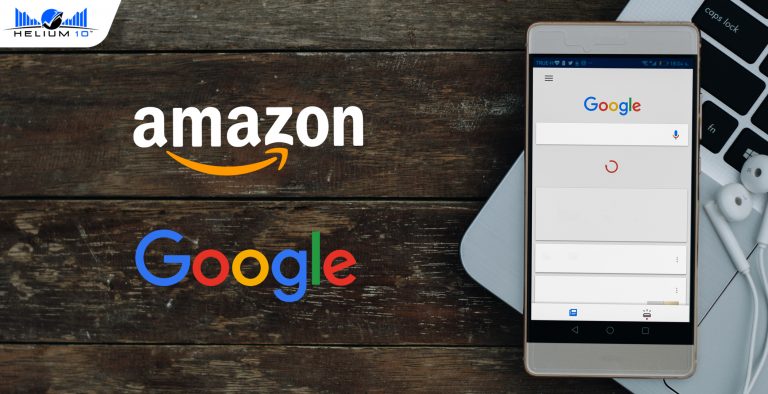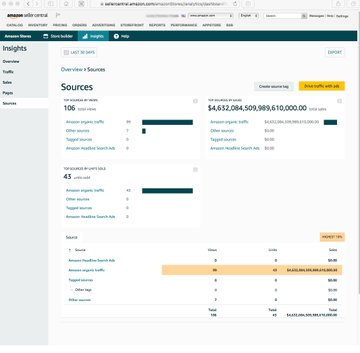
In a Bloomberg interview with JumpShot, a marketing analytics firm, CEO Deren Baker explains that the company’s research indicated that over 54 percent of all product searches on the Internet now take place on Amazon.
With customers using Amazon more than any other source on the Internet to search for products, should Amazon SEO take precedence over that of Google?
In a time where people are using Amazon to perform more product searches than actual search engines like Google, optimizing your product listing using Amazon SEO data has never been more critical.
In a Bloomberg interview with JumpShot, a marketing analytics firm, CEO Deren Baker explains that the company’s research indicated that over 54 percent of all product searches on the Internet now take place on Amazon.
Some other JumpShot facts that Amazon sellers may find interesting include:
- Product views via sponsored ads have increased from 3 percent to 7 percent in the last 18 months
- 90 percent of all product listing views are the result of a direct product search via the Amazon search engine
- 2/3 of all clicks into product listings after receiving search results occur on the first page
Amazon product searches account for just over half of all product search inquiries, making it quite clear that being visible on Amazon itself must take center stage in any seller marketing plan. With this information being made public, the issue many sellers are still facing is using regular Google SEO to promote their products without regard to Amazon SEO.
Amazon SEO VS Google SEO
Many of Amazon’s private label merchants do not realize that keywords and phrases have different dynamics within Amazon’s search engine. Where Google is a search engine for EVERYTHING on the Internet, Amazon is a search engine for PRODUCTS on its own website.
There are several differences in the way Amazon and Google operate, including the following:
Keyword Placement and Structuring
- Amazon – While long-tail keywords are encouraged for more accurate search results, individual keywords can be placed anywhere throughout an Amazon product listing with special emphasis placed on keywords included in the listing title.
- Google – Exact keywords and phrases are placed next to each other and make up no more than 2 percent of the body text in addition to the title and metadata.
Monetary Gains
- Amazon – The e-commerce platform makes its money from product purchases, so Amazon facilitates the easiest means of letting customers buy products directly on the website.
- Google – The search engine makes its money through advertising and clicked links from companies offering products or services, but not necessarily if the customer makes a purchase.
External Backlinks
- Amazon – The platform does not support external linking since the Amazon SEO model does not consider external linking relevant to customers purchasing a product on the website.
- Google – The search engine gives preference to URLs that have backlinks attached to them from other reputable websites; the more backlinks point to a URL, the stronger it is in the Google rankings.
Clicks
- Amazon – While clicking into listings can demonstrate popularity, they do not affect page ranking as much as actual purchases.
- Google – Click-through rates (CTR) mean everything to Google, as it says a particular link (or product) must be popular and deserves a top organic ranking
Conversions
- Amazon – Product listings on Amazon earn higher page ranking based on their number of sales; CTR (click-through rate) is not as critical if clicks do not turn into purchases
- Google – Product listing advertisements on Google earn higher page ranking based on their number of clicks; conversions are not as important
An overwhelming majority of customers will find your products through the Amazon search box rather than clicking on an advertisement on Google, Bing, or even Facebook, so ensuring your Amazon SEO is performing well should be your first priority.
The Growing Need to Stand Out on Amazon
In addition to being visible within the confines of Amazon’s marketplaces, sponsored ads for products on Amazon have also seen growth as their necessity increases.
One factor that both Amazon and Google share is their reliance on PPC marketing campaigns to drive traffic.
For Google, driving traffic drives clicks, and they will offer top billing to whoever will pay most for keywords.
For Amazon, paid ads help externally, but are more heavily invested within the parameters of a respective Amazon marketplace.
While sellers are certainly encouraged to invest in Google ads and Facebook ads, Amazon ads will have a more direct effect while customers are actively in Amazon searching for a product like yours.
How to Create Amazon Facebook Ads for Killer Product Launches
How to Set Up Facebook Offers to Distribute Amazon Single-Use Coupon Codes
Make More Money & Get Top Ranking with Chatbot Facebook Marketing
Choose an Amazon Seller Tool That Provides REAL Amazon Data
In order to get your Amazon SEO right, you’ll need to do your product research and keyword research using real Amazon data.
Data derived from Google regarding Amazon product searches can often be skewed or out of date, leading many sellers to have false notions about the state of their private label businesses.
Helium 10 gets every bit of its powerful information straight from Amazon itself, providing the most accurate picture of your product niche. Powerful tools like Black Box, Xray, Magnet, Cerebro, and those in the Helium 10 Chrome extension all rely upon the most accurate Amazon data so you can create your Amazon SEO plan efficiently.









Nulla sed mi leo, sit amet molestie nulla. Phasellus lobortis blandit ipsum, at adipiscing eros porta quis. Phasellus in nisi ipsum, quis dapibus magna. Phasellus odio dolor, pretium sit amet aliquam a, gravida eget dui.
Integer vel libero arcu, egestas tempor ipsum. Vestibulum id dolor aliquet dolor fringilla ornare. Nunc non massa erat. Vivamus odio sem, rhoncus vel bibendum vitae, euismod a urna. Aliquam erat volutpat.